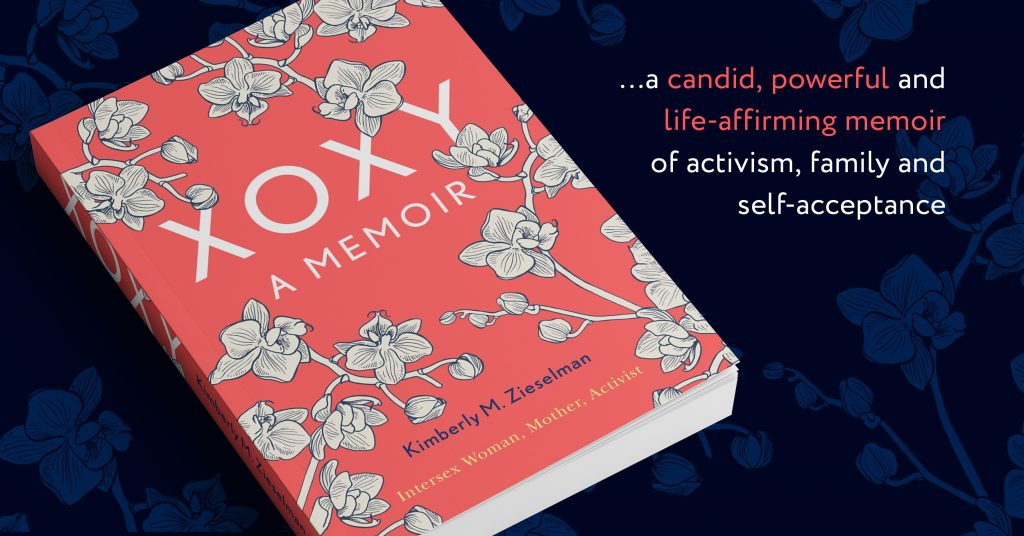
I never intended to write a memoir. As the description of my book on Amazon says, “Meet Kimberly, a regular suburban housewife and mother.” But I think we all have stories to tell and mine began to come to light the day I discovered my childhood medical records and read the words ‘male pseudo hermaphrodite.’
“Hermaphrodite—that sounded like a mythological being—born with male and female parts. Testicular Feminization—what the hell was that?”
(XOXY, p. 22)
Then began a journey of self-discovery, self-acceptance and transformation into an advocate.
“Over the last decade, I met or heard stories about hundreds of women with the very same intersex condition—CAIS—discovered when they were children when surgeries on inguinal hernias revealed unexpected testes. Some were like me and didn’t know the truth until adulthood. Others who may have known lived in the shadows of an unsupportive family. Like me, so many were told they too were rare, alone. Like me, so many believed they were freaks. Together, we recognize we are us, amazing, and absolutely normal people with bodies that happened to have been born a little bit different, healthy variations of nature. Bodies aren’t as binary as we were all taught in school.”
(XOXY, p. 122)
The fact is, nearly 2% are born “intersex,” with one or more physical sex characteristics (such as internal reproductive organs, chromosomes or genitals) that don’t match up with what we typically think of as either a “male” or “female” body. As many as 1 in every 2,000 infants are still at risk today of receiving irreversible and harmful cosmetic surgeries in attempt to “fix” their genitals and erase their intersex traits. And they are given no choice. These medical procedures often case pain, scarring, infertility and lack of sensation. They almost always caused emotional trauma for the young patient. Just ask them later when they become adolescents and later, adults. Thankfully more and more intersex people like me are beginning to speak out – this awareness raising and advocacy to change medical practice are urgently necessary.
Today I direct interACT, the world’s largest intersex led advocacy organization whose sole mission is to stop medically unnecessary and harmful interventions on intersex children without their consent. It’s a violation of their human rights to bodily autonomy and to be free from harm. In many ways, what is being done to intersex children is like so called “gay conversion therapy” where children are subjected to harmful physical and psychological practices in effort to erase the homosexuality out of them. Doctors have been surgically erasing healthy intersex bodies for years.
“Therein lies what I think is the core reason why it makes perfect sense for intersex to become part of the broader LGBTQ+ movement. While many, if not most, intersex people, me included, identify as straight and cisgender, most of us experience shame, stigma, discrimination, and harm simply because our bodies are deemed different or unacceptable by mainstream society. This fear of bodily difference and non-binary bodies is similar to the fear of people’s sexual orientations and non-binary gender identities. In fact, I believe that it is this fear of bodily difference, akin to homophobia, intersexphobia if you will, that drives some doctors to recommend, and parents to agree to, medically unnecessary surgery on intersex children and infants. I am convinced that such doctors want to erase the intersex parts of us to fit us into strictly binary-looking ‘male’ or ‘female’ bodies.”
(XOXY, p. 205)
I wrote XOXY to help increase intersex visibility and decrease the stigma and misconceptions that continue to drive medical providers to perform, and many parents to authorize, well-intended, but incredibly harmful interventions on otherwise happy and health intersex children. It starts with education and the widespread sharing of experiences by intersex people and their families. Additionally, many of the intersex stories being shared today come from people who also identify as gay or trans. And those are incredibly important narratives. But it’s my hope that by showing readers that the “regular suburban housewife and mother” living next door might also be intersex, somehow helps to reduce the fear and phobia surrounding this topic. Ultimately allowing intersex children to be joyfully welcomed into the world and to grow up without stigma, shame and the harmful results of surgeries done without their consent.
“I watched out the floor-to-ceiling window as the sky grew dark that afternoon, the city skyline in front of me, and thought, woe- we were doing it. We were bringing the issue of intersex mainstream. Even more people would soon know what the word means and what the experience is. The world was learning that we exist. Invisible no more.”
(XOXY, p. 230)